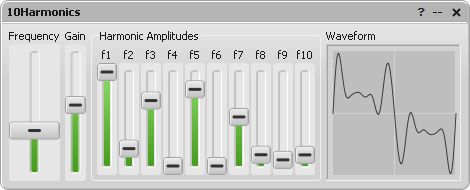| AudioMulch Help > Contraption Reference > Signal Generators | Previous Next |
10Harmonics
Synthesizes a harmonic tone by controlling the amplitude of the first 10 harmonics (additive synthesis).

10Harmonics is a ten harmonic additive signal generator. The output is the sum of ten sinusoidal oscillators spaced at integer multiples of the fundamental frequency. You can select the fundamental frequency of your tone, and then add varying amounts of the first ten harmonics to create tones with different harmonic content. A display of the output waveform is provided and you can adjust the overall gain of the output.
 |
See the Adjusting Contraption Properties section for information about using sliders, knobs, presets etc. |
Related Contraptions
Parameters

Frequency |
Controls the fundamental frequency (f1). Frequency ranges from 20 to 2000 Hz. |
Gain |
Controls the output volume. |
Harmonic Amplitudes (f1-f10, Amp_1-Amp_10) |
Controls the amplitude of each harmonic. The sliders indicate the gain of each harmonic. |
Waveform |
Displays a normalized view of the composite waveform. |
Relevant Example Files
The following files provide examples of how 10Harmonics can be used:
ShapeSynth.amh, TheAudienceIsMulching.amh, TheBells.amh, WaveSequence.amh & OvertonesAutomation.amh.
 |
To open the Example Files directory, go to the File menu, select Open, and double-click on the Examples folder. Read descriptions of the example files here. |
Technical Discussion
10Harmonics is based on the concept of additive synthesis – synthesis of sound by summing (mixing) sinusoidal components. This derives from the idea that complex musical sounds can be created by combining a series of individual sine waves (sinusoids), otherwise known as harmonics or partials. In a physical system such as a string or tube, these partials would correspond to the resonant modes of the system.
As the partials in 10Harmonics are tuned according to the harmonic series (i.e. each partial has a frequency which is an integer multiple of the fundamental), the resulting sound is often percieved as a single tone at the fundamental frequency, rather than as a mixture of sine tones. The relative strengths of the harmonics affect the timbre of the resultant sound.
| Previous Next |
